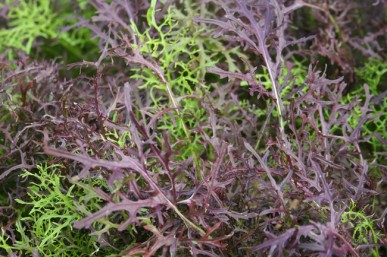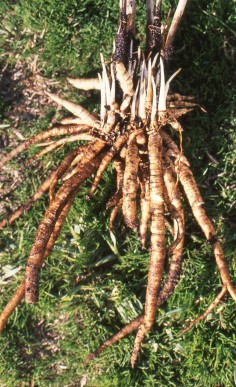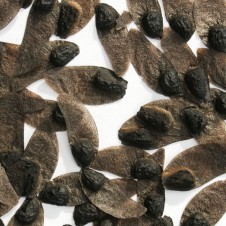
The finely divided leaves of red mustard

Peppery lime green and red leafed mustard
My favourite edible plant in the garden at present is red mustard (Brassica rapa ’Ruby Streak’) also known as mustard ruby streaks. This finely divided salad leaf can grow as tall as 60cm but is usually a bit smaller. The leaves have a sharp lemony flavour with a hot peppery after taste. I graze on it fresh from the garden, add handfuls to salads, chop it and combine with cream cheese on biscuits, or put it into sandwiches. Older leaves are great in stirfries if added at the last minute. The more leaves you harvest the more they will grow. Lime streaks mustard has green leaves and a similar flavour, but I think the red leafed form has the edge. Read more
Article and photo by Gail Thomas

Skirret tubers taste of carrot, parsnip and parsley

Botanical illustration of Sium sisarum. Prof. Dr. Otto Wilhelm Thomé Flora von Deutschland, Österreich und der Schweiz 1885 http://commons.wikimedia.org/wiki/File:Illustration_Sium_sisarum0.jpg
When the Friends of Geelong Botanic Gardens published a facsimile edition of its first curator Daniel Bunce’s 1838 The Manual of Practical Gardening adapted to the climate of Van Diemen’s Land, there among the plantings was skirret which produces the ‘sweetest, whitest and most pleasant of roots’.
Skirret (Sium sisarum) is a hardy perennial native to China and Japan is a member of the carrot and parsley family and was enjoyed widely in Europe back in the fifteenth century. The fleshy tuberous sweet white roots form in prongs from a crown, do best in cooler areas and can also be propagated from seed.
Skirret is hardy, grows to around 60cm -1m, prefers full sun but tolerates light shade, likes rich moist soils and should be lifted as required during winter – it is said roots are sweeter after the first frosts.
With a taste hinting of parsnip, carrot and parsley, skirret can be simply scrubbed before being boiled, baked, braised or creamed with mashed potato. It can also be added to soups, stews and curries or grated raw into salads and served simply with a vinaigrette dressing. The root can also be roasted as a coffee substitute and is believed to cleanse the bladder, treat jaundice and other liver disorders.
The Manual of Practical Gardening by Daniel Bunce from the Friends of Geelong Botanic Gardens ph (03) 5222 6053 or [email protected] (see Reviews on this site for more information about this book) and skirret plants from Island Herbs, Snug, Tasmania ph (03) 6267 9218 or [email protected]
 Adapted to the climate of Van Dieman’s Land:
Adapted to the climate of Van Dieman’s Land:
Containing Plain and Familiar Directions for the Management of the Kitchen, Fruit, and Flower Garden, Nursery, Green-House, and Forcing Department.
For every month of the year.
By Daniel Bunce
This fascinating facsimile of the original book written by Daniel Bunce in 1838 looks at gardening month by month in the new colony. Daniel Bunce arrived in Hobart in 1833 after establishing his own nursery he published his ‘Practical Gardening’ month by month, starting with July. When it was finished, all the monthly bulletins were bound together and sold to the general public. In 1857 Bunce was appointed Curator of the Geelong Botanic Gardens. This facsimile has been published by The Friends of the Geelong Botanic Gardens and copies can be obtained by emailing The Friends at [email protected]
So I looked to see what I should be doing this month and found that I should be sowing spinach and parsnip seed, planting out cabbage and cauliflower seedlings, blanching endive and manuring artichoke plants. All still absolutely right and relevant today, nearly 175 years later. The pages are full of gardening wisdom, such as this last comment for July ‘Every part of the garden should now be kept very clean (of weeds), as if the seeds are suffered to grow they will get ahead and prove troublesome all the following season.’

Rosemary has many medicinal uses
Rosemary (Rosmarinus officinalis), a native of the Mediterranean, is a woody shrub which can grow to a height of 1 m. It has short, tough leaves densely bunched on the stems, and pale blue flowers in winter. There are several cultivars including ‘Tuscan blue’ and ‘Blue lagoon’, which are dwarf forms with dark-blue flowers; ‘Roseus’ with pink flowers; ‘Albus’ with white flowers; ‘Aureus’, which has leaves speckled with yellow; and ‘Prostratus’, a prostrate form. Most rosemaries can be grown from seed sown in spring and all grow well from cuttings taken in spring or summer. Rosemary likes a sunny, well-drained position with a slightly alkaline soil. It can be slow growing at first, but will need to be pruned regularly after the first two years. The prostrate and dwarf varieties are excellent for rockeries or hanging baskets. Harvest rosemary whenever it is needed.
Read more



This is a great new site where you can purchase native Victorian seed. I have to admit that I am a biased champion because the site is run by my sister Libby and her husband Steve, and it was designed by my son Dan (who also designed my site). The intention of the website is to provide information about, and to sell a diverse range of seed for the Melbourne and Central Victorian region. Their seed is different from that available from some other sources as they have set up their own Seed Production Area (SPA) so that their seed is not taken from remnant populations of indigenous flora. For more information about their SPA and the steps they have taken to make the seed as genetically diverse as possible, visit the site, look at the beautiful pictures and learn about the years of work that have been undertaken in order to establish this fledgling business. The catalogue page is a work of art, as well as being an easy way to order seed. Go to Victorian Native Seed
 This lovely book is the perfect introduction to edible organic gardening. It is packed with clear and accessible information and photographs about composting, soils, pests and diseases, as well as an A-Z of edible plants. It also explains in simple terms how to get started, what is meant by terms like organic, permaculture and biodynamic and how to test your soil. Scattered through the book there are clear step-by-step pictures of making no-dig gardens and vegetable beds, as well as growing green manure and laying irrigation systems, how to espalier and much more. While probably more suited to the beginner gardener, there is also information here for the more experienced gardener. A great addition to the organic gardening literature; you would expect no less from two such knowledgeable garden writers.
This lovely book is the perfect introduction to edible organic gardening. It is packed with clear and accessible information and photographs about composting, soils, pests and diseases, as well as an A-Z of edible plants. It also explains in simple terms how to get started, what is meant by terms like organic, permaculture and biodynamic and how to test your soil. Scattered through the book there are clear step-by-step pictures of making no-dig gardens and vegetable beds, as well as growing green manure and laying irrigation systems, how to espalier and much more. While probably more suited to the beginner gardener, there is also information here for the more experienced gardener. A great addition to the organic gardening literature; you would expect no less from two such knowledgeable garden writers.
Borrow it from you library or buy it from your local independent book shop.
by Jennifer Stackhouse & Debbie McDonald, Murdoch Books, $29.95 (digital copies $19.95)










